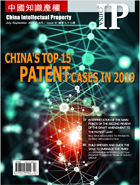One of the controversial issues involved in this case is how to determine the technical problems actually solved by patents based on the effects that can be achieved by distinguishing technical characteristics. When determining the technical problems actually solved by the invention in inventiveness judgment, first determine the role, function or technical effect of the distinguishing technical features in the patented technical solution and then make an appropriate induction and summary on this basis.
First trial case number: (2018) Beijing 73 Administrative Preliminary Judgment No. 9181
Second trial case number: (2019) Supreme People’s Court Intellectual Property Administrative Final Judgement No. 32
【The main takeaway of the trial】
When determining the technical problems actually solved by the invention in the process of inventiveness judgment, the technical problems should be properly summarized according to the role, function or effect of the distinguished technical features in the technical solution of the patent. It cannot be generalized too much, nor can it simply equate the effect, function or technical effect achieved by distinguishing technical features with the technical problems actually solved by the invention.
【Case Introduction】
Appellant (defendant in the original trial): China National Intellectual Property Administrative
Appellant (third person in original trial): Kashi Sol-Bright Technology Co., Ltd. (referred to as Sol-Bright Company)
Appellee (plaintiff in the original trial): Shandong HAOWO Electric Co., Ltd. (referred to as HAOWO Electric Company)
This case involves a utility model patent with the patent number 20152043 ×××× .5, titled “A photovoltaic module and its automatic cleaning device”, the patentee is Sol-Bright Company, the application date is June 24, 2015, the priority date is December 23, 2014, and the authorization announcement date is November 25, 2015. In response to the above patent rights, HAOWO Electric Company submitted a request for invalidation to the Patent Reexamination Board of the China National Intellectual Property Administrative (hereinafter referred to as the Patent Reexamination Board) on January 30, 2018, and submitted corresponding materials. On the same day, the Patent Reexamination Board issued a notice of acceptance of the invalidation request to both parties and forwarded the invalidation request and the accompanying copies of evidence to Sol-Bright Company. The Patent Reexamination Board made a decision on the complaint on July 24, 2018 to maintain the patent right of the utility model involved. HAOWO Electric Company refused to accept the decision and filed an administrative lawsuit in Beijing Intellectual Property Court.
The original judgment of the Beijing Intellectual Property Court ruled: first, revoke the examination decision on invalidation request No. 36657 made by the Patent Reexamination Board of the China National Intellectual Property Administrative; second, the Patent Reexamination Board of the State Intellectual Property Office re-examined the request for invalidation of the utility model patent filed by HAOWO Electric Company on the patent number 20152043 ×××× .5, titled “A PV module and its automatic cleaning device.” The case acceptance fee of 100 yuan shall be borne by the Patent Reexamination Board of the China National Intellectual Property Administrative. The China National Intellectual Property Administrative and Sol-Bright Company did not accept the judgment of the court of the first instance and appealed to the Supreme People's Court.
The second instance of the Supreme People's Court held that the facts found in the original trial were unclear and the application of the law was wrong and should be revoked. The prosecuted judgment found the facts clear and the applicable law was correct. The judgments are as follows: 1. The Beijing Intellectual Property Court (2018) Beijing 73 Xingchuchu No. 9181 Administrative Judgment was revoked; 2. The Shandong HAOWO Electric Co., Ltd.’s lawsuit was rejected. The handling fee of 100 yuan for the first and second instance cases shall be borne by HAOWO Electric Company.
【Typical meaning】
In the "problem-solution" idea used in inventiveness judgments, three steps are generally followed: determining the closest prior art; determining the distinguishing features of the invention and the technical problems actually solved by the invention; determining whether the claimed invention is obvious to a person skilled in the art. In the second step, when determining the actual problem solved by the invention, the closest prior art is usually used as a reference, based on the analysis of the distinguishing features of the invention compared with the closest prior art, the technical effects that the distinguishing features as a whole can achieve are determined. Therefore, the technical problem to be solved by the invention is to improve the closest prior art to provide better technical effects than the closest prior art. In this sense, the technical problems solved by the invention are objective, and the determination of the distinguishing characteristics is the basis for understanding the technical problems actually solved by the invention. On this basis, the technical effects that can be obtained by a person skilled in the art after reading the contents described in the description should also be considered.
One of the controversial issues involved in this case is how to determine the technical problems actually solved by patents based on the effects that can be achieved by distinguishing technical characteristics. When determining the technical problems actually solved by the invention in inventiveness judgment, first determine the role, function or technical effect of the distinguishing technical features in the patented technical solution and then make an appropriate induction and summary on this basis. The court of the second instance clearly pointed out that when inducing and summarizing in order to determine the technical problem actually solved by the invention, it cannot be generalized too much, thus underestimating the inventiveness of this patent, nor can it simply equate the effect, function or technical effect achieved by distinguishing technical features with the technical problems actually solved by the invention, thereby overestimating the inventiveness of this patent.




